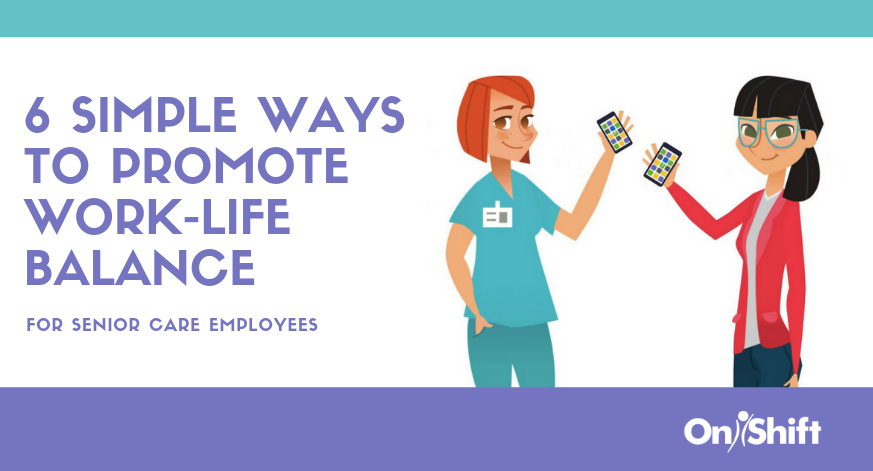May 3, 2019 | Jenna Berris
May 3, 2019 | Jenna Berris
 Technology has changed the way we live and work, and too often blends life and work so seamlessly that we forget to establish barriers between the two. Employers need to be mindful of work-life balance and encourage it among employees. This is especially true of senior housing operators, where caregivers deal with intensive workloads and often work long hours.
Technology has changed the way we live and work, and too often blends life and work so seamlessly that we forget to establish barriers between the two. Employers need to be mindful of work-life balance and encourage it among employees. This is especially true of senior housing operators, where caregivers deal with intensive workloads and often work long hours.
No need to overhaul any of your current processes; here are six small but impactful ways providers can encourage work-life balance, prevent burnout and reduce employee turnover.
1. Bring Families To Work
Many companies host “bring your child to work” day and encourage employees to bring families to functions such as award ceremonies and holiday parties. Providers can easily incorporate this practice. Invite employees’ families to community celebrations and group activities. Doing this gives families a deeper look and better understanding of the inner workings of a senior care community and can help develop personal relationships among employees. Not to mention, exposure to life at your community has the potential to plant a seed for younger family members looking to find a career path.
2. Make Meals To-Go
Providing food and beverages, although a small gesture, can go a long way in showing employees you care. Providers should consider the occasional free lunch or a meal to take home to the family. If that isn’t feasible, many companies make to-go meals available for employees at a reduced cost. This saves time on dinner prep and allows them more time with their families.
3. Encourage Efficiency
Technology is here to stay, and the long-term care and senior living industries are catching on to the potential upside of implementing tech in daily operations and management. From record keeping, to scheduling employees, to billing vendors and clientele, many manual process can be automated today. By providing the right tools, technologies and training for employees, providers can help senior care staff do their jobs more efficiently, saving them time, reducing stress and improving your organization’s productivity.
4. Set Boundaries
Access to smartphones is arguably the biggest shift to the work-life balance conundrum. There are two schools of thought when it comes to cellphones in the workplace.
Some communities ask caregivers to stay off their phones during their shift, and some, like Commonwealth Senior Living, for example, ask employees to use their discretion. I tend to side with the latter policy. Cell phones are an integral part of how our society communicates, and mandating a no-use policy seems harsh and could lead to staff dissatisfaction.
What if someone abuses the privilege, you ask? Well, those instances should be handled on a case-by-case basis. I think you’ll find that employees want to keep your trust and will use their mobile devices responsibly.
5. Provide Mobile Schedules
Providers who embrace employee scheduling software stand to gain a whole lot: visibility into future overtime to control, balanced staffing, increased efficiencies. However, one of the biggest benefits is that your employees gain the ability to swap shifts, pick up shifts, request personal time off and view their schedules anywhere at any time -- right from their phones. No more coming in on their day off to check the schedule or phoning in and tracking down the scheduler to request PTO next month.
Of course, with the advent of these programs, providers should be mindful to not bombard employees with messages around the clock. That's why OnShift's mobile app allows employees to set their communication and notification preferences to fit their needs.
6. Promote Best-Fit Schedules
Many caregivers are either juggling multiple jobs, in school or caring for family. Some may be doing all three. Work with employees to find out when they want to work and let them adjust their preferences to better align with their other priorities. Allowing employees to have a say in when they work, not only promotes work-life balance and satisfaction, but can better help you as a provider identify true hiring needs.
A happy caregiver is a productive one. These recommendations can go along way in helping senior care providers boost employee satisfaction, prevent burnout and ultimately, reduce turnover.
Subscribe to the OnShift Blog
Recent Posts
Categories
About Jenna Berris
Jenna Berris is a Content Marketing Manager for OnShift.
See for yourself why thousands of providers rely on OnShift’s innovative software for recruitment, hiring, workforce management, pay and engagement. Request your personalized demo today.
